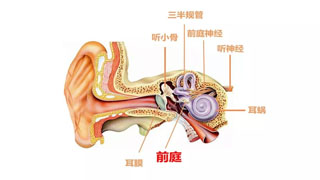
In front of the brainstem in the posterior lower part of the brain, there is a tiny sensory organ called the vestibular nucleus, which is the gatekeeper of brain information. The nervous system composed of it, the vestibular system, closely coordinates with the balance system to form vestibular sensation.
The vestibule is an important sensory organ that maintains balance in the human body, located in the inner ear and composed of three semicircular canals, an elliptical sac, and a balloon. It plays a crucial role in maintaining balance and spatial orientation in the human body.
There are many vestibular functions:
1. Filtering various sensory channel information into the brain has a significant impact on audio-visual learning.
2. Manage human balance and spatial orientation sensing, as poor performance can interfere with balance and spatial perception.
3. It is closely related to the development of other sensory systems, affecting eye tracking, concentration, reading ability, and guiding muscle tone development and posture function integration.
4. It is closely related to children's language development, and poor vestibular system can affect language development.
Vestibular functional motor regulation is reflected in horizontal motor function, rotational balance, and reflex regulation. The position and movement of the head are perceived and transmitted through the vestibular organs, including the three semicircular canals, the utricle, and the balloon. The perceived signals are transmitted to the brain through the auditory nerve.
The working principle of vestibular receptors is that head displacement or rotation causes the flow of endolymphatic fluid, activating hair cells in the membrane labyrinth to produce signals. The elliptical sac and balloon transmit linear acceleration or deceleration signals, while the semicircular canal senses rotational motion.
In the structure of the inner ear, the vestibular organ is the body's sensory organ for its own movement and head position. When the body moves, changes in speed stimulate sensory cells in the semicircular or elliptical sacs, and changes in head position stimulate sensory cells in the balloon. These stimuli cause neural impulses to propagate along the vestibular branch of the eighth cranial nerve to the central nervous system.
The vestibular system is closely related to gravity, auditory system, three-dimensional spatial awareness, cerebellar function, behavior in dynamic environments, attention, emotional stability, motor tolerance, sound and visual localization, oral movement, etc., supporting various aspects of sensory processing. Normal vestibular function regulation allows us to make adaptive behaviors based on the environment.
In the "quiet feeling", normal vestibular signals are necessary for maintaining human posture and other functions, and usually maintain a subconscious state. The vestibular eye reflex can maintain eye and body stability during head movements, and this reflex is trainable. Unilateral vestibular signal input can also proceed normally, but complete loss seriously affects motor ability.
Insufficient advanced vestibular function can cause dizziness or nausea, and individual adaptation may vary. Its transmission pathway includes the vestibular sensory information of head movement being transmitted to the vestibular nucleus of the brainstem through the vestibular nerve, the brainstem reticular structure connecting relevant nerve nuclei, the visual information of the retina partially projected to the vestibular nucleus, and the involvement of the vestibular cerebellum in regulating reflexes.
In the pathway of balance perception, there are various manifestations of insufficient proprioception, such as poor balance, poor coordination, spatial perception problems, language problems, visual problems, concentration problems, etc.
Vestibular function testing includes observing whether there is balance disorder in a quiet state, and further evaluation includes static, dynamic, and comprehensive evaluation methods. Evaluation methods suitable for athletes include closed eye, single foot standing eagle posture test, and wooden step test.
Vestibular dysfunction is characterized by poor balance, easy falling, poor control of distance and direction, jumping and missing words when reading, as well as physical coordination and movement problems, visual problems, spatial perception problems, and lack of concentration due to information filtering disorders.
Training methods for vestibular dysfunction include somersault, prone dragon ball, etc., which can exercise vestibular balance and strengthen vestibular function. Timely sensory integration training is necessary to stimulate the development of vestibular function.


